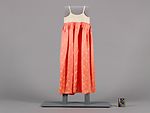chima (Skirt)
About this object
History of use
This fabric, “Yang-dan” or western satin, was very popular in the 1950s for clothing worn at festivals and special occasions. It was imported from Hong Kong and was sometimes called “Hong Kong yang-dan”. It is now being revived for women’s festival clothing. The straps attached to the curved shape of the skirt band were innovations introduced after the opening of Korea to the outside world in the late 19th century, replacing the simple waistband with long ties of the traditional “Chi-ma”. The new style was considered to be more modest, as it covered the breasts, and more comfortable.
Narrative
Most of the clothing in the J. McRee Elrod Collection was made for him and his family by friends while they were living in Korea, much of it by Kim, Sung Sook. She and her family lived cooperatively in the same house as the Elrod family. While they were there, the Elrods preferred to wear Korean clothing on very cold days and for social occasions. They found it to be more comfortable than western clothing in cold weather, as public buildings were unheated in the period immediately following the Korean War. It also was more comfortable for floor seating in Korean homes, and easier to store with limited furniture than western clothing. The children’s clothing was worn by their children Mark and Lona.
Iconographic meaning
Ginko fruit and leaves are symbols of long life.
Specific techniques
The skirt is sewn with machine stitching except for the finishing of the hem, which is hand-stitched with a blanket stitch called “Sae-bal-teu-gui”, “bird’s foot shaped stitching”.
Physical description
Skirt made of two panels of shiny coral pink brocade with a woven overall pattern in white of gingko flowers and leaves. The skirt is open at the back and overlaps when tied. The panels are pleated and inserted into a band of unbleached cotton, the upper edge of which is scalloped, with the points of the scallops meeting the ends of two shoulder straps of the same material. At the ends of the band are long ties of the same material.
Date Made
1955-1960
Date Acquired
13 Oct 1976
How Acquired
Donated
Credit Line
Measurements
Overall: 87 cm x 34 cm
Object Number
Ed1.328
